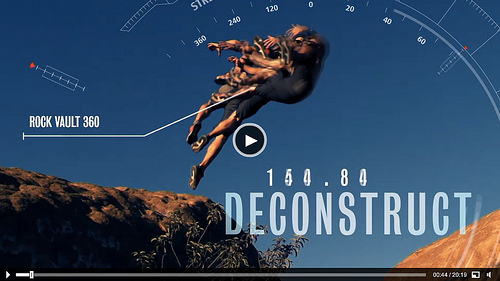Timothy Ferriss's Blog, page 107
December 9, 2013
The Ugly New York Times Bestseller — The Creative Process in Action
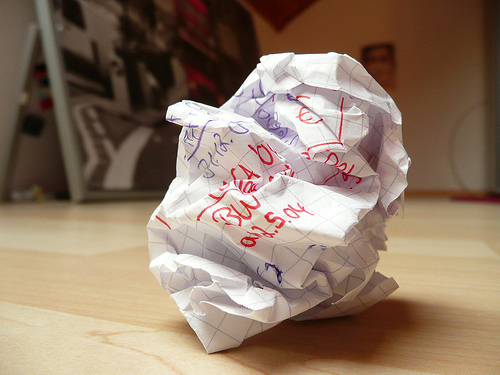
(Photo: photosteve101)
“Put down everything that comes into your head and then you’re a writer. But an author is one who can judge his own stuff’s worth, without pity, and destroy most of it.”
- Sidonie-Gabrielle Colette
“Substitute ‘damn’ every time you’re inclined to write ‘very’; your editor will delete it and the writing will be just as it should be.”
- Mark Twain
Writing isn’t a clean process.
In general, attempting to be creative isn’t a clean process. It’s filthy. I wish I could poo diamonds, but — alas — I am not built for such miracles. Instead, I plod and stumble my way through revisions, hacking at mental cobwebs and killing inner demons. Eventually, enough caffeine and wine permitting, I might look down and see something that doesn’t make me gag.
To give you an idea, below are some hand edits of the Introduction to The 4-Hour Chef, which–much improvement later–hit the NYT and WSJ bestseller lists in November of 2012. As I write this, it’s hovering around #180 on Amazon. Keep in mind that the below is after 5-10 drafts:
Download a full-size PDF of my edits here
Even this simple blog post, as one example, was revised and rewritten 14 times. The iteration pays off — it ended up getting 700+ comments. Conversely, one-take wonders usually get burned at the stake, and rightly so.
“Revising,” “iterating” (in start-up speak), “editing”…no matter what you call it, it’s tweaking something bad or mediocre until it finally works. As Ernest Hemingway said, “The first draft of anything is shit.”
This applies to much more than writing. Ernest would no doubt agree that my first attempt at a blog was shittier than shitty. Here are the “before” pics from 2007. Note that my friend Ramit Sethi and others had equally hideous “rough drafts” of their sites. It’s par for the course…
Here’s the first Apple computer. Ground-breaking, to be sure, but it’s not exactly as sleek as a Ferrari. It didn’t need to be.
How often we self-sabotage in the name of “perfectionism”! Perfectionism may be better than sloth, but it can become a clever hand-waving exercise. “Not yet!” one might say (and I have said often). More research, more preparation, more interviews, more… procrastination. Let’s call it what it often is: a forgiving term for a terrible habit. It’s like calling someone “eccentric” instead of “crazy.”
To create anything remarkable, it takes not one giant leap after perfect prep, but many baby steps in the right direction once you have barely enough to get started.
To start something big, you have to first start something small. From a past interview of mine on the creative process; note the bolded portion:
“I do my best writing between 10 p.m. and 5 a.m.. Almost every friend I have who is a consistently productive writer, does their best writing between 10 p.m. and 8 a.m. My quota is two crappy pages per day. I keep it really low so I’m not so intimidated that I never get started. I will do the gathering of interviews and research throughout the day. I’ll get all my notes and materials together and then I’ll do the synthesis between 10 p.m. to bed, which is usually 4 or 5 a.m.”
How can you take something you’re putting off and make the first step tiny?
How can you use an easy quota like “two crappy pages per day” to get started?






December 8, 2013
Jony Ive’s Secret Coffee Ritual

Jony Ive and his elite design team at Apple are coffee snobs. And rightfully so.
Coffee is the fuel that drives their brainstorming sessions, which are arguably the most important meetings in the design department. These sessions are where Apple has birthed some of the greatest products of all-time: the iMac, the iPod, the iPhone, and the iPad.
In this guest post by Leander Kahney (author of Jony Ive: The Genius Behind Apple’s Greatest Products), you’ll learn the secret coffee ritual performed by Jony Ive’s design team.
Remember: Apple’s standards are notoriously high. As is the case with their products, Apple’s coffee is not for those with meager budgets…or without Monk-ish tendencies.
HOWEVER, for almost every uber-expensive ideal, I’ve indicated the Poor Man’s alternative that I personally use. It’s not hard to cheaply get it about 90% right.
Enjoy the obsessive detail…
Enter Leander
Jony Ive and his team work in a super-secure design studio on Apple’s campus in Cupertino, California. Locked behind a heavy door and lined with frosted glass windows, few are allowed to enter the inner sanctum, including some of Apple’s own executives.
The studio is Apple’s innovation factory — Edison’s lab at the heart of the company. You can tell it’s the brains of the operation from the hundreds of patents they file. Some of the designers are among the top patent holders in the world. The studio is where Steve Jobs hung out most afternoons before he died, working on new products with Jony Ive.
A team of about 20 designers work in the studio. Twice a week, the entire team gathers together for brainstorming sessions. The brainstorms take place around a large table in the studio’s kitchen.
The brainstorms are the key to how the designers work. “We can work with a level of collaboration that seems particularly rare,” Ive has said. “In fact, the memory of how we work will endure beyond the products of our work.”
The brainstorms are usually on Tuesdays and Thursdays, running for three hours — from 9:00 AM to roughly 12:00 PM.
Such marathon thinking periods would be impossible without coffee.
Before each brainstorming session, the team performs their sacred coffee ritual — a critical part of their workflow since the early 1990′s. Like everything Apple’s designers do, their coffee ritual is very precise. They have honed their technique to a science, adjusting the beans, the grind, the grain, and the pour to perfection. The resulting beverage boosts the team’s creativity to the max.
How to Make Coffee like Jony Ive
Step 1: Get a High-End Espresso Machine
Apple’s design studio is equipped with a high-end commercial-style espresso machine. For a long time, the machine was an Italian Grimac. But the $3,000+ machine leaked all the time and had to be constantly serviced by a technician. Yet it made heavenly coffee. Thanks to the studio’s ultra secrecy, it’s unclear if the same machine is in service or has been replaced.

Italian Grimac – Apple’s old machine
Good espresso machines come in all shapes and sizes, but smaller machines good for home use cost between $800 and $1,300.
Machines from European companies like Rancillo, La Pavoni, Pasquina, Bezzera (the company that invented espresso in 1905) and Gaggia are recommended. The 1,300 Bezzera BZ07 ($1,200) is highly rated, but the Kees van der Westen Speedster ($7,200) has been called the best home espresso machine ever.

Kees van der Westen Speedster: The best espresso maker ever?
If $1,000 is too steep, you can get an espresso-like experience using the AeroPress ($25), a cylindrical device that’s part-bicycle pump, part-French Press. As Tim details in The 4-Hour Chef, it’s the machine of choice for top professional baristas.
[NOTE FROM TIM: Here's my 4-minute tutorial on how to make the perfect cup of coffee with an AeroPress:]
Step 2: Get a Good Grinder
The coffee grounds have to be perfectly uniform — each has to be exactly the same size – to allow the water to envelope the grain and extract the coffee. If the grounds are too big, the water will pass through too fast and you won’t get full extraction. If the ground is too small, powdery grains clog up the filter and the water won’t get through. It can also force coffee grains into the cup. Yuck!
The size of the grain is the most important factor in making perfect espresso. Therefore, a good grinder is of utmost importance.
A burr grinder uses two interlocking burrs to precisely crush beans into granules of exactly the same size. It’s like two stones milling flour, but on a micro level. The best grinders allow the gap between the burrs to be adjusted between 5 to 10 microns, which is about the size of a red blood cell.
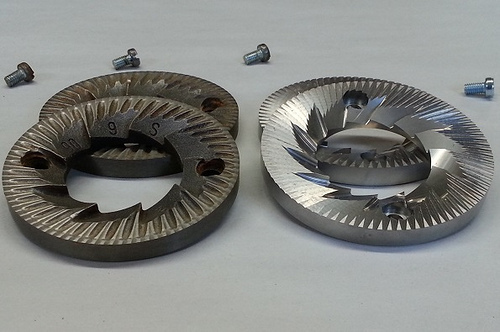
A good stepless burr grinder is going to cost between $600 and $1,000. The Mazzer Mini Espresso Grinder ($640) is built like a tank and loved by espresso enthusiasts. However, you can get a hand-cranked burr grinder that works very well for $30 to $90. Tim uses Hario Mini Mill ($30), an easy-to-use conical grinder that’s adjustable (very important).
Every time you have a different type of coffee or different roast, the grind has to be adjusted. Sometimes the grinder has to be calibrated batch-to-batch of the same bean and roast.
Under no circumstances should you use a common household blade grinder, which chops the coffee beans with a whirling blade like a blender. What comes out is a powdery mess with all sizes of grain, both big and small. This is a coffee crime. The length of the pour can’t be controlled and it’s the easiest way to get a mouthful of coffee grains.
Step 3: Use Fresh Beans
When Steve Jobs returned to Apple, one of the first things he did was jazz up Apple’s internal cafeteria, known as Caffè Macs. The chefs installed a coffee roaster that regularly delivers 5 lb. bags of coffee to the studio. The roaster is underneath Building 4 on Apple’s campus, and complaints of the overwhelming coffee smell forced the kitchen staff to roast beans on the weekend. A fresh batch is now roasted every Saturday.
Fresh beans are an essential ingredient for great coffee. Ideally, roasted beans shouldn’t be more than five days old. After five days, the beans start to deteriorate fast.
A good source of fresh beans is Tonx’s coffee subscription service, with plans starting at $12 monthly.
Tim uses mostly Blue Bottle and Intelligentsia beans.
Step 4: Grind the Beans and Load The Puck
The amount of coffee you put into the puck should be carefully measured using an accurate pocket scale, such as the American Weigh SC-2KG ($20).
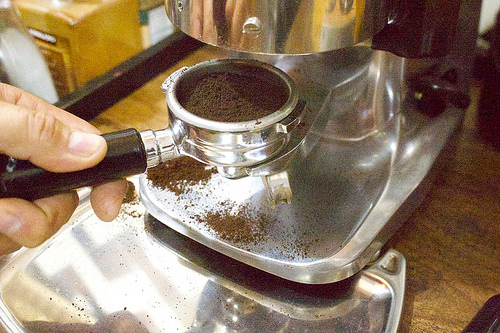
Maintaining the right density is critical. If the coffee is too dense, the water won’t pass through. If it’s not dense enough, the water will pass through too quickly. Coffee purists argue about the right amount of pressure, but 30-ft/lbs has emerged as a popular standard.
The density of the coffee can be kept constant with the use of Espro’s calibrated tamper ($90), a steel pestle for packing coffee grounds into the espresso puck).

Step 5: The Pour
Here’s the tricky part. After grinding and weighing the grounds, packing it into the puck with 30-ft/lbs of pressure, you’ll need to calibrate the pour time.
The pour time must be constant, and it can’t be messed with. The optimum pour time is 28 seconds. It must not, under any circumstances, exceed 30 seconds.
Hit the start button, then time exactly how long the machine takes to make your first cup of coffee.


If the coffee is made in say, 18 seconds, the water is coming out too fast because the grains are too large.
If it takes longer than 30 seconds, the grains are too small. Go back and adjust the burr on the grinder.
Keep trying until you’ve made a cup that pours in 28 to 30 seconds — not a second shorter, and not a second longer. You can usually hone in on the right grain size in about three pours.
Step 6: Add Milk
Apple’s team was first introduced to high-end coffee by Daniele De Iuliis, a British designer of Italian descent. He taught the other designers about the importance of the grind, the crema, and how to properly froth the milk.

Espresso machines use pressured steam to foam a jug of milk. High-powered machines produce ample steam; the secret is good technique.
Most people don’t foam their milk correctly. Newbies foam it with air bubbles that are too big. Correctly foamed milk is actually “micro-foam” and is great for making patterns. If your barista makes a leaf on your latte, rest assured the milk was foamed correctly. If you see a barista banging the milk container on the counter, you know they screwed up and made the bubbles too big (banging the jug on the counter brings the bubbles up).
The most important factor is a chilled container ($10), preferably made of stainless steel. The pros keep their milk containers in the freezer. Milk foams before it boils, and a chilled container prolongs the foaming process by keeping the milk at the optimum temperature for longer.
Hold the steamer just below the surface of the milk. When the milk gets hot and the foaming stops, its time to take the steamer all the way to the bottom of the container. Keep steaming until the milk reaches 160 degrees Fahrenheit. Use a small thermometer ($10) hooked over the lip of the jug to measure the temperature. [In a pinch, the milk is ready when the jug gets too hot to hold.]
Some recommend using full-fat milk, but the fat content of the milk doesn’t matter. In fact, low-fat milk foams just as well as creamier milk.
This video from Paul Meikle-Janney, Head Judge for the World Latte Art Championship, has some great tips and technique for getting foam right:
Step 7: Enjoy!
Making coffee like Apple’s design team is a complicated but fascinating experience.
Once you’ve mastered the process, an intoxicating aroma will envelop your entire kitchen (or office). Your morning beverage will become unbelievably rich and smooth, without a trace of bitterness. That is the right way to start off a productive day.
For Starbuck’s sake, they should hope Jony stays in the computer business.
# # #
BONUS: Do you have a great coffee tip? Tell us in the comments! Leander will be sending an AeroPress, the Hario Mini hand grinder, and a signed copy of his book – Jony Ive: The Genius Behind Apple’s Greatest Products - to the person who leaves the best comment.
Also, would you like to see more rituals of top performers? Let me know in the comments — anyone’s schedule in particular you’d like to see on this blog?






December 1, 2013
Assets and Fun for “The Tim Ferriss Experiment” — Please Share!
I don’t do purely promotional posts often, but this is a special occasion — the premiere of my TV show! Special thanks to Brendan Gahan, who helped organized the below materials.
Sharing any of the below helps ensure I can film more episodes for y’all. Thank you in advance! Much more content coming (about Jony Ive, actually) soon.
Here goes…
IMAGES OF QUOTES & ANIMATED GIFS
If you feel so inclined, below are some images with quotes from the show as well as a few fun animated gifs for you to easily share. Please note, if you download the images and upload any of them your Twitter account directly, it will take up a bit more real estate in the newsfeed (and lead to more exposure for the show). Have fun and enjoy.
IMAGES
One of the best ways to learn something fast is to set stakes #TFX (IMAGE )
Innoculate yourself against making mistakes when you’re afraid #TFX (IMAGE 1) (IMAGE 2)
What other impossibles do I have in my life, that I should really question? #TFX (IMAGE 1) (IMAGE 2) (IMAGE 3)
D.I.S.S. Deconstruction, Selection, Sequencing & Stakes #TFX (IMAGE 1)
What’s up now David Lee Roth? #TFX (IMAGE 1)
M.E.D. The Minimum Effective Dose to unlock this song #TFX (IMAGE 1)
GIFS
Swewart showing me the ‘annoying things guitarists do’ (GIF)
That annoying thing guitarists really do, do #TFX (GIF)
The pressure. The pressure. (GIF)
The 80/20 rule (GIF)
Stewart drumming like he lives in The Matrix #TFX (GIF)
QUOTES TO TWEET
I’ve pulled some of my all time favorite quotes, as well as some memorable lines from the show for. You can simply click to tweet and I’ll count all of these as entries to my contest.
Some of my all time favorites:
“A life spent making mistakes is not only more honorable, but more useful than a life spent doing nothing.” – George Bernard Shaw #TFX (Click To Tweet)
“You have enemies? Good. That means you’ve stood up for something, sometime in your life.”#TFX – Winston Churchill (Click To Tweet)
“A life spent making mistakes is not only more honorable, but more useful than a life spent doing nothing.” #TFX – George Bernard Shaw (Click To Tweet)
“Worrying is like praying for what you don’t want.” #TFX via Aileen Norton Swift (Click To Tweet)
“A goal is not always meant to be reached. It often serves simply as something to aim at.” #TFX – Bruce Lee (Click To Tweet)
What other impossibles do I have in my life, that I should really question? #TFX (Click To Tweet)
Memorable lines from the show:
What other impossibles do I have in my life, that I should really question? #TFX (Click To Tweet)
What’s up now David Lee Roth #TFX (Click To Tweet)
I need to figure out the minimum effective dose to learning this song, the smallest piece I can focus on to pull this off #TFX (Click To Tweet)
One of the best ways to learn something fast is to set stakes. #TFX (Click To Tweet)
Innoculate yourself against making mistakes when you’re afraid #TFX (Click To Tweet)






Premiere! The Tim Ferriss Experiment – Live Tweeting, Giveaways, Q&A, Behind-The-Scenes, and More
The big night has come: the premiere of The Tim Ferriss Experiment!
Starting now (3pm PT, 6pm ET) and ending around 8pm PT/11pm ET on December 1st, I’ll be doing everything possible to get #TFX to trend high on Twitter. If you’re seeing this the day after, it’s still important!
This is a new critical metric that TV show execs are using to determine success or failure. Traditional Nielsen rankings aren’t enough.
Want to see my attempts to deconstruct parkour, professional poker, guns, language learning, and much more? Please help me ensure this first episode does well!
See below for how you can best help…
FIRST, WHAT I’LL BE DOING
- Live Twitter Q&A from 4:30pm PT (7:30pm ET) to at least 6pm PT (9pm ET). Ask me anything, but you must include #TFX.
- Giveaways! I’ll be giving away super cool stuff, including:
Subscriptions to my Quarterly packages
Merrell shoes
Signed books, including mine and Vagabonding.
Sonos Playbars ($700 sound system)
Goodies related to the drumming episode
And much more…
HOW YOU CAN HELP:
If you’re up for it (and it’d mean the world to me), here are the things you can do to help. This TV show has been years in the making…
If you have cable, tune in to “The Tim Ferriss Experiment” on HLN at 5pm PT (8pm ET). If you can’t make it today, please DVR it and watch in the next few days. It counts.
If you don’t have cable, please watch the show online starting at exactly 5pm PT (8pm ET). YouTube is here, and iTunes is here. I’ll offer play-by-play commentary and live Twitter Q&A on what you’re seeing.
In any case, please participate in the live Twitter Q&A and giveaways! Use #TFX as much as possible. Original tweets are worth more than retweets of other people.
Do whatever you can to get people to use #TFX on Twitter between now and midnight! Rally the troops, your friends, your mailing lists, your Facebook friends, your imaginary friends… Offer giveaways of your own using #TFX, reuse your most popular tweets using #TFX, etc.In short, as Gary Oldman in The Professional would say:
IMAGES OF QUOTES & ANIMATED GIFS
Special thanks to Brendan Gahan, who helped organized the below materials.
Sharing any of the below helps ensure I can film more episodes for y’all. Thank you in advance! Much more content coming (about Jony Ive, actually) soon. Here goes…
If you feel so inclined, below are some images with quotes from the show as well as a few fun animated gifs for you to easily share. Please note, if you download the images and upload any of them your Twitter account directly, it will take up a bit more real estate in the newsfeed (and lead to more exposure for the show). Have fun and enjoy.
IMAGES
One of the best ways to learn something fast is to set stakes #TFX (IMAGE )
Innoculate yourself against making mistakes when you’re afraid #TFX (IMAGE 1) (IMAGE 2)
What other impossibles do I have in my life, that I should really question? #TFX (IMAGE 1) (IMAGE 2) (IMAGE 3)
D.I.S.S. Deconstruction, Selection, Sequencing & Stakes #TFX (IMAGE 1)
What’s up now David Lee Roth? #TFX (IMAGE 1)
M.E.D. The Minimum Effective Dose to unlock this song #TFX (IMAGE 1)
GIFS
Swewart showing me the ‘annoying things guitarists do’ (GIF)
That annoying thing guitarists really do, do #TFX (GIF)
The pressure. The pressure. (GIF)
The 80/20 rule (GIF)
Stewart drumming like he lives in The Matrix #TFX (GIF)
QUOTES TO TWEET
I’ve pulled some of my all time favorite quotes, as well as some memorable lines from the show. You can simply click to tweet.
Some of my all time favorites:
“A life spent making mistakes is not only more honorable, but more useful than a life spent doing nothing.” – George Bernard Shaw #TFX (Click To Tweet)
“You have enemies? Good. That means you’ve stood up for something, sometime in your life.”#TFX – Winston Churchill (Click To Tweet)
“A life spent making mistakes is not only more honorable, but more useful than a life spent doing nothing.” #TFX – George Bernard Shaw (Click To Tweet)
“Worrying is like praying for what you don’t want.” #TFX via Aileen Norton Swift (Click To Tweet)
“A goal is not always meant to be reached. It often serves simply as something to aim at.” #TFX – Bruce Lee (Click To Tweet)
What other impossibles do I have in my life, that I should really question? #TFX (Click To Tweet)
Memorable lines from the show:
What other impossibles do I have in my life, that I should really question? #TFX (Click To Tweet)
What’s up now David Lee Roth #TFX (Click To Tweet)
I need to figure out the minimum effective dose to learning this song, the smallest piece I can focus on to pull this off #TFX (Click To Tweet)
One of the best ways to learn something fast is to set stakes. #TFX (Click To Tweet)
Innoculate yourself against making mistakes when you’re afraid #TFX (Click To Tweet)
Thank you in advance for your support. It’s what keeps me going.






Premiere Tonight! The Tim Ferriss Experiment – Live Tweeting, Giveaways, Q&A, Behind-The-Scenes, and More
The big night has come: the premiere of The Tim Ferriss Experiment!
Starting now (3pm PT, 6pm ET) and ending around 8pm PT/11pm ET, I’ll be doing everything possible to get #TFX to trend high on Twitter.
This is a new critical metric that TV show execs are using to determine success or failure. Traditional Nielsen rankings aren’t enough.
Want to see my attempts to deconstruct parkour, professional poker, guns, language learning, and much more? Please help me ensure this first episode does well!
See below for how you can best help…
FIRST, WHAT I’LL BE DOING
- Live Twitter Q&A from 4:30pm PT (7:30pm ET) to at least 6pm PT (9pm ET). Ask me anything, but you must include #TFX.
- Giveaways! I’ll be giving away super cool stuff, including:
Subscriptions to my Quarterly packages
Signed books, including mine and Vagabonding.
Sonos Playbars ($700 sound system)
Goodies related to the drumming episode
And much more…
HOW YOU CAN HELP:
If you’re up for it (and it’d mean the world to me), here are the things you can do to help. This TV show has been years in the making…
If you have cable, tune in to “The Tim Ferriss Experiment” on HLN at 5pm PT (8pm ET). If you can’t make it today, please DVR it and watch in the next few days. It counts.
If you don’t have cable, please watch the show online starting at exactly 5pm PT (8pm ET). YouTube is here, and iTunes is here. I’ll offer play-by-play commentary and live Twitter Q&A on what you’re seeing.
In any case, please participate in the live Twitter Q&A and giveaways! Use #TFX as much as possible. Original tweets are worth more than retweets of other people.
Do whatever you can to get people to use #TFX on Twitter between now and midnight! Rally the troops, your friends, your mailing lists, your Facebook friends, your imaginary friends… Offer giveaways of your own using #TFX, reuse your most popular tweets using #TFX, etc.
In short, as Gary Oldman in The Professional would say:
Thank you in advance for your support. It’s what keeps me going.






November 26, 2013
Premiere TV Episode! “The Tim Ferriss Experiment” — Online for Free
You asked, and I heard you.
To those outside of the US, and to those of you who don’t own TVs — we’ve done two things:
- All episodes of The Tim Ferriss Experiment will be available on iTunes.
– The first full episode is entirely free and available everywhere online! This includes…
iTunes (highest resolution, fastest load times) — Please watch here and leave a review! Pretty please.
Xbox
PlayStation
Amazon Instant
Google Play
Upwave brand site
YouTube — Again, would really appreciate the views and reviews on iTunes, if possible.
Just for this post, I’ve disabled comments below. Please let me know what you think of Episode One on this page! This has been a labor of love, and I hope you enjoy it.
ALSO: For the TV premiere — 8pm ET (5pm PT) this Sunday on HLN — I will be live tweeting (#TFX) from about 7:30-9pm ET (4:30pm-6pm PT), including Q&A, giveaways, and behind-the-scenes goodies. Please join me!
Much more to come… 






November 11, 2013
The Tim Ferriss Book Club Launches — Book #1: Vagabonding
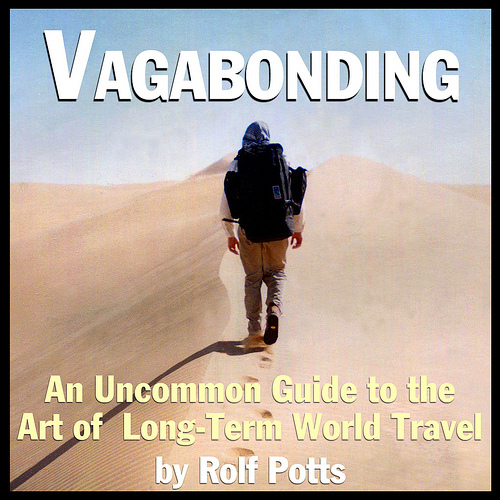
The book Vagabonding traveled with me around the globe for 18 months.
This post is a dream come true.
Starting in college, I’ve fantasized about somehow driving fantastic but under-appreciated books into the limelight. I have a soft spot for out-of-print tomes and niche publications.
Flash forward, nearly 15 years later…
After three #1 bestsellers, I’ve finally pulled the trigger. For the last several months, I’ve been quietly buying audiobook and e-book rights to books that have changed my life, and producing audiobooks in professional studios.
Fun!
This post launches the Tim Ferriss Book Club, and the first book is incredible: Vagabonding.
Why a Book Club?
There are several reasons…
I was greatly influenced by books recommended by Oprah Winfrey’s Book Club (e.g. Love in the Time of Cholera), despite the fact that I wasn’t her demographic.
I could never find a book club for 20-40-year old males, or a curator for that demo. I’m now in a position to give it a shot myself (and extend it to women, of course).
Based on recent experiments (BitTorrent and elsewhere), I think I can at least double an author’s print sales with my marketing of their audio/e-book. I like helping good writers.
This blog’s community is incredible…and we like books (see comparison to TV and NYT Op-Ed impact). The idea of having thousands of people read the same book each month, all interacting with one another and the book’s author, is thrilling to me. And, last but not least…
You’ve asked me to start a book club for years!
The time has come.
This leads us to Rolf Potts and a little tome with a huge impact…
Why Vagabonding?
“Vagabonding packs a serious philosophical punch and has a cult-like following among independent travelers…”
— The Oregonian
“This book will become a travel classic, and belongs in all travel collections.”
— Library Journal
Starting in 2004, I traveled the world for roughly 18 months. The lessons learned formed the basis for much of The 4-Hour Workweek.
On my journey — from the back alleys of Berlin to the hidden lakes of Patagonia — I had next to nothing: one suitcase, one backpack, and only two books. One of those books was Walden by Henry David Thoreau (naturally), and the other was Vagabonding: An Uncommon Guide to the Art of Long-Term World Travel, written by Rolf Potts.
Since 2005, I’ve continued to read 1-3 books per week on average, or 50-150+ books a year.
Vagabonding easily remains in my top-10 list for life-changing books. Why? Because one incredible trip, especially a long-term trip, can change your life forever. And Vagabonding teaches you how to travel (and think), not for one trip, but for the rest of your life. Tim Cahill, founding editor of Outside magazine and a brilliant travel writer himself, has said of Vagabonding, “I think this is the most sensible book of travel related advice ever written.”
In my own dog-eared copy of Vagabonding, I have notes, underlines, and highlights on practically every page, ranging from the tactical (how to pack intelligently, what to bring, what not to bring, where to go, etc.) to the philosophical (the Upanishads, how to slow down after a lifetime of rushing and caffeine, etc.). I also have a wish list of dream destinations on the inside cover, including places like Stockholm, Prague, Paris, Munich, Berlin, and Amsterdam. The list goes on and on.
Using the Rolf’s tips, the same tips you can learn in Vagabonding, I checked them all off. I was able to explore many of them for 2-3 months at a time at my own pace, unrushed and unworried. It was a dream come true.
Everything in Vagabonding works. This book changed my life completely, and I wish the same for you.
Enjoy the adventures. May you have many of them.
Here is Chapter One from the brand-new audiobook, which includes new case studies and a Preface by yours truly:
From there, each chapter is better than the last. Click here for the full audiobook.
If you’re an author, agent, or publisher who’d like to talk about including your book in the Tim Ferriss Book Club, please tell me here.
###
Still on this page? Let’s keep going, then.
Here’s the jacket description of Vagabonding:
“Vagabonding” is about taking time off from your normal life — from six weeks, to four months, to two years — to discover and experience the world on your own terms. Veteran shoestring traveler Rolf Potts shows how anyone armed with an independent spirit can achieve the dream of extended overseas travel, once thought to be the sole province of students, counterculture dropouts, and the idle rich. Potts gives the necessary information on:
Financing your travel time
Determining your destination
Adjusting to life on the road
Working and volunteering overseas
Handling travel adversity
and re-assimilating into ordinary life
Not just a plan of action, vagabonding is an outlook on life that emphasizes creativity, discovery and the growth of the spirit.
More goodies:
- Reader and media praise for Vagabonding
- Vagabonding BitTorrent Bundle
- Vagabonding excerpt on YouTube (Part II – “Someday” is a disease)
Any special requests for this book club? Ideas or suggestions? Please let me know in the comments.
We’ll have some special reader-only events with Rolf soon, so be sure to listen to the book! It’s also available on iTunes, but it helps both Rolf and me more if you download the book through Audible.
I hope you benefit from this book as much as I have over the years. If you pay attention, it can change your life.






November 8, 2013
How to Dominate Any Tradeshow, and Why Even Solo Entrepreneurs Should Try

Lance Kalish and Ido Leffler of Yes To Carrots
Intro by Tim
How do you build a multi-million dollar global business?
Well, you might start by visiting Israel and negotiating the rights to an unknown brand (Yes To Carrots)…found in 16 stores. Then, you might use cold calling artistry and Jedi mind tricks to get carried by Walgreen’s in its 7,000+ stores. Next, you might get your product into 25,000+ stories internationally and smile when you see Rosario Dawson using your goods publicly. Now, as the happy ending (of sorts), every 6 seconds in the US, someone buys a Yes To product!
But that’s leaving out the details, isn’t it? I hate business articles and books that do that.
I’ve known Ido Leffler, Yes To’s co-founder, for ages. I met him at a Summit Series event in Miami. His trademark hug was the first thing that caught my attention: inexplicably slow-motion and super gentle, as if he were cradling a baby panda. Of course, there’s his subtle Australian accent and persuasive (and deliberately less subtle) Israeli chutzpah. Who the hell was this guy? I’ve come to love him, but perhaps more important to you, I’ve come to love his methods. He deconstructs problems like Sherlock Holmes with a twist of Richard Branson…
His partner Lance is even more methodical. In many respects, he is to Ido what Steve Wozniak was to Steve Jobs. That’s part of the reason their partnership works. To paraphrase one of Yes To’s investors: “He [Lance] is the numbers guy, and he [Ido] is the pictures guy.”
This post by Ido and Lance explains their methodical approach to tradeshows. But why should you care about tradeshows, if you don’t already? I used tradeshows (e.g. SXSW, lounges at CES) to successfully launch The 4-Hour Workweek to the bestseller lists. You can use tradeshows to network with people who would otherwise never return your email or phone call.
Tradeshows can be — even for a solo entrepreneur — the best single use of time in a given year, and Ido and Lance know how to make it count.
For the full Yes To story, you’ll need to grab their new book, for which I wrote the Foreword. The book explains, step-by-step, how they went from selling out of a suitcase to building the second largest and fastest growing natural beauty brand in the US, with almost 100 unique products (or “SKUs,” pronounced “skews”).
It’s tempting to write that the Yes To story is a beautiful example of the American Dream. But that’s not quite right.
It’s the Australian Dream.
It’s the British Dream.
It’s the Indian Dream.
It’s the [fill in the blank] Dream.
Ido and Lance’s story is the dream of doers everywhere–the dream of making something happen, of creating something meaningful from nothing.
Have you ever had a job and thought “I could do a better job than this guy” while watching your boss? Have you ever thought of an invention for solving a common problem and asked “Why hasn’t someone DONE this yet?!?” If so, you’ve found the right teachers.
Before I hand the mic over to the Australians, I could say “May the wind always be at your back,” but that’s not how this game works.
Instead, I’ll recommend that you gird up your loins (figuratively), grab a cup of coffee, and prepare for an adventure.
Enjoy the ride…
Enter Lance and Ido
This post everything we know about how to extract the most value from a trade show.
Keep in mind that we threw together our first U.S. trade show booth with nothing but hope, good vibes, a modest budget, and a fortuitous Google search that led us to an amazing design firm in Israel and a builder in Hungary who were able to build our booth for pennies on the dollar.
Trade shows are absurdly expensive; save money on everything but don’t skimp on your visual presentation. Sleep underneath the registration table. Eat nothing but stale pretzels. Shave in the McDonald’s bathroom. But make sure that your booth looks fun, deluxe, well designed, and tells a compelling story. You need it to catch buyers’ eyes as they run past you to the established businesses in the primo spots on the convention floor. Trade shows are an incredibly useful weapon to get introductions to massive retailers, and no matter how much you think you know about international retail, there are always going to be retailers out there that you’ve never heard of and whose stores you need to be in. So give it your all. Presentation is everything.
Ido: When we first started Yes To we would attend the National Association of Chain Drug Stores convention in San Diego every year. It’s a huge deal; literally everyone who is anyone in health and beauty is there. We always had the same spot, year after year; and so did the guy a few booths down from us. Now, I admired our neighbor’s products. They were well formulated and effective. But I struggled to understand his approach to selling these products. Every year he had the same collapsible table, covered in the same tablecloth, with a dropdown backdrop showcasing his products. He wore a slightly scruffy suit and stood morosely at his table, rarely engaging with anyone he didn’t already know. In other words, he had a great product and a terrible presentation; his table looked cheap, he seemed uninterested, and no one was going to fall in love with cheap and uninterested. You don’t need ridiculous amounts of money to make an impact, but if you’re working with a minimal budget, you need to brings tons of imagination and effort and add something unique to your presentation. Don’t go with a little table and a pull-down sign at the back. You don’t need to spend a lot of money — just be different.
The Taj Mahal booth

Ido: What do we mean by different? We mean be bloody different. A few months after we shook hands with Walgreens on our online exclusive, I went to an industry conference in Hong Kong called the Cosmoprof convention. I’d squeezed Lance for about 200 percent more money than he thought we could afford; it was still a minuscule budget by the standards of a big trade show. We’d found an architect in Israel who designed a fantastic, modern, über-hip booth for us and the aforementioned builders in Hungary who were willing to build it for a fourth of the cost of Israeli contractors. Nobody knew anything about us except that we were the brand new company with the over-the-top, bright orange, sexy booth. The booth had a carrot structure that rose like an orange Taj Mahal over the rest of the exhibitors. The green fronds brushed the ceiling and could be seen from any point on the floor. We filled it with energetic young people, glowing with good health, who handed moisturizer samples and carrot juice to everyone who walked by. Basically, we were the party booth, and we were packed from morning to night. Turns out that our structure was ten feet too high and broke every rule of the convention center, but we managed to stall the demolition team till the last day. By the time the convention wrapped, we’d drunk our own weight in carrot juice many times over, but we’d also made hundreds of new friends and new contacts. Success. Now when we attend conferences we do it with an even more fantastic booth than we had at the last event. Other companies recycle their booths for decades. What’s fun about that! Sometimes the booth will have a Frank Lloyd Wright look to it, other times it will be futuristic, but it is always big, orange, and fun. No matter what, our booth changes every year and is always the one that people are talking about on the opening day of the convention. A first impression is always going to be the most lasting impression. There is a certain expectation that your booth and your presentation will reflect the reality of your business’s size and market share.
This is an expectation that we chose to ignore. Our booth reflected the company we planned to be in a few years, not the company we were at that moment. So you don’t need the biggest booth or the biggest budget. But at the same time, you can’t simply follow the norm of having a plasma screen playing a generic video or hosting a random giveaway or competition.
By the end of a trade show, people want two things:
• They want to be entertained.
• They want free stuff.
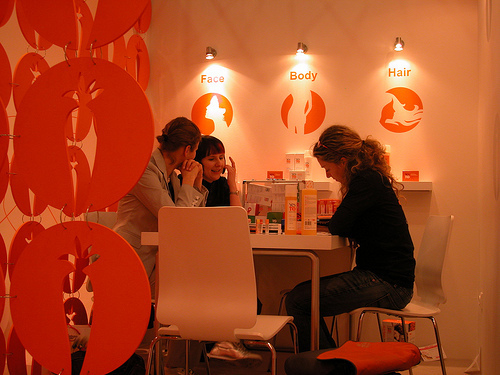
If you can make them laugh and send them home with a bag of goodies, then you have a reasonable chance of getting them to remember you. Think of a trade show as speed dating on a massive level. Every account in that convention hall has the opportunity to sit down with every buyer for three minutes. In those 180 seconds you need to find some way to click with them, make them laugh, give them an insight into your brand’s philosophy, put some samples in their hands, offer them a carrot juice and a key ring, and hope and pray that they felt the same little spark that you did. It always shocks us when we see brands not putting a 150 percent effort into a trade show. I feel personally offended when I see attendees sitting down and reading the paper or sneaking out early. What’s the point? Attending a trade show is a massive investment, especially if you’re a small company with a modest budget. Don’t slack off even when you see your competitors half-assing it. In fact, look at their half-assing as an opportunity for you to wow the retailers they are underwhelming.
The Master’s Degree of Trade Shows: Working the Show
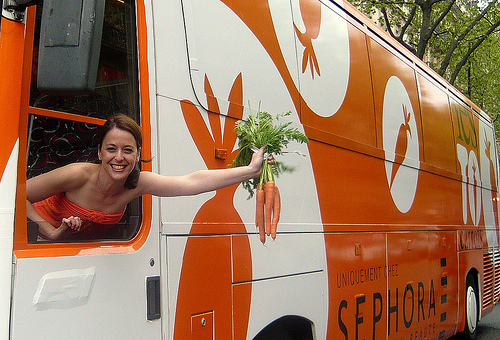
Lance: In our early days with Yes To we made a huge effort to attend the Cosmoprof convention in Italy. This was a biggie, and we put down a huge amount of cash to fly our team out, assemble gift bags, and make our booth look fantastic. By the end of day two, though, our booth was quiet; all the good-looking carrots, handing out juice, and the team couldn’t get people interested. For whatever reason our magic wasn’t clicking. “What the hell are we going to do?” I wondered. “This is a disaster.” “Why?” Ido asked.
“Because our booth is empty, and it’s been empty all day!” Ido laughed.“Mate, we built this booth to meet one person, from one account. I’ve met him, he loves us, and nothing else matters.”
Have goals. Be strategic. Know whom you need to meet and what kind of business you need to do with them. Identify your “whales,” the most important people you want to meet at a trade show. It’s critical that your team knows the names (and ideally the faces) of the whales on your hit list. Make sure they understand that if Mr. or Ms. Whale shows up, then they need to get your attention immediately. Trade shows are full of perfectly charming people who are lots of fun but essentially irrelevant to your business. If you are talking to one of these people, and you miss your chance to talk to the whale, then you are in trouble.
Ido: I’ve shamelessly run after a whale that got away; Captain Ahab would be proud of me! After all, this might be the only day your particular Moby Dick attends the trade show. Do not miss your opportunity to talk with them. Manifesto Rule Numero Uno: Turn the convention hall into a walking billboard about you and your brand. Conventioneers love tote bags. Why? Because there are tons and tons of free stuff to be had, and after about two hours they are going to need something to carry the swag in. We always order thousands of great tote bags. No cheap paper or thin cotton for us. Our bags are big, bright, and unique, and by day two we try to make sure that every single person in the hall is carrying one. Be shameless and be fun. Slap your logo on the bag, add some bright colors, and make sure that people instinctively smile when they see it. Have tons of product to give away at the booth, and give it away freely. Don’t be one of those guys withholding the good stuff for the “big guys.” Instead, be the guy with the product that everyone is using and talking about. Freely distributing swag (even if it costs you) is in your best interests; you want those walking adverts wandering the convention.
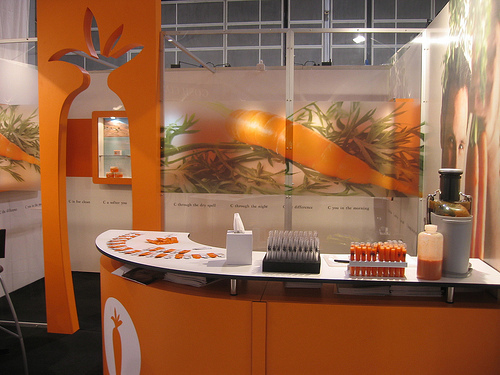
Try to stay in the hotel where the important people are staying, because you want to be able to interact with them in the elevator, in the bar, or at breakfast. A two-minute conversation in the breakfast buffet line can be invaluable if it creates a tiny bond or shared experience between you and an important buyer. Give yourself the chance to have that moment. These hotels are expensive, but it is so, so worth the extra cost if you are able to use it to your advantage. Always make sure you and your team have a uniform — and not a suit. Order some logo shirts, but make sure they are funny, not droney. Do something goofy and unexpected. Order everyone in the team those East Coast preppie trousers that are covered with embroidered whales. Have fun with it, but whatever you come up with, make sure it makes you stand out. You want to be a little bit different and also be comfortable, so don’t wear a corporate, uninviting suit. One caveat: It’s useful to have someone who looks more conventional in your booth. Some of your meetings will be with a person who needs the reassurance of seeing someone who looks a little square. Lance: At every damn trade show Ido sees me putting on my jeans and polo shirt and says, “I’m dressing cool, you dress like the accountant.”
Ido: That’s just because of your terrible taste in jeans. No, we need one guy who looks serious and traditional, and seriousness comes more naturally to Lance. Note: The more conventional, reserved-looking guy should not be the boss or, in our case, both of the bosses. Make sure that at least one of the founders or the CEO is wearing the more casual look, like everyone else. You want your CEO or founder to be fun and superapproachable. You don’t want him or her wearing a suit and sitting in one spot and looking like a monarch on a throne. Keep the boss approachable, and don’t create the impression that you have an impenetrable hierarchy. Buyers buy from people they know, like, and trust. Give them a chance to build that relationship with the head guy, even if it is the one and only time they will ever have anything to do with him. Always have a pen and paper, or an iPad, or a voice recorder handy. As soon as you finish a meeting, scribble down all the pertinent information: name, contact info, and any details you can recall. Small talk is everything, and six months later you may be glad you remembered that their youngest is playing ball at State, or that they grew up in an area you know well. Send a follow-up note to everyone you contacted over the course of the day, and every evening debrief with your team so you figure out who to delegate your new contact to. Keep the initial note brief; no one has the time or energy to read a detailed letter while the show is still running.
Once you are back home, give them a couple of days to settle back and then hit them again with an action-based e-mail. Always remind them who you are, and refer back to your notes. If you have a personal comment that feels appropriate, such as, “I hope John’s first day of school went well,” make it. Know how to cut your losses; if someone says, “I am coming back,” without scheduling an actual time to return and talk, it means they are never coming back, ever. Let it go. The minute the trade show closes for the day is the minute the real work begins.
Practice the fine art of thinking while drinking

Lots of the important business at a trade show is done after the convention closes for the day. In order to get in on these opportunities, you need to be organized, aggressive, and targeted. Plan ahead. You want at least one after-hours social interaction with all your potential partners, retailers, distributors, press, and even your competitors. You need to start planning these social interactions months before the convention, so start calling and e-mailing and Facebooking well in advance of the show. Don’t be afraid to approach people whom you’ve never met or who feel “out of your league.” Everyone is in the same boat of wanting to connect with people and discover the next big idea before their competitors do. This makes it relatively easy to get a meeting at a convention that you might struggle to get in day-to-day life.
You are at that convention to build relationships and make friends, and the after-hours booze fest known as “cocktail hour” is a great place to do so. For better or worse, conventions are fueled by alcohol; this can be challenging if you don’t drink, but either way, it’s critical to be out there taking part. Conventions, especially the after-parties, can also be tricky if you’re not a naturally outgoing person. I have friends and coworkers who are great in the more structured environment of the convention floor but struggle with the after-hours socializing. It’s critical that you are genuine, relaxed, and unguarded, so find something about the evening that you enjoy. Go to karaoke. Laugh. Have fun. Say yes to after-dinner drinks and late-night drinks; late-night drinks is where you can form the strongest relationships. People are relaxed, they open up a bit, and you will have a really memorable shared experience to refer back to as your relationship develops.
Lance: Ido and I never sit together at these after-hours events. We spend plenty of time together as it is! You should chat and catch up with your partner only when you go back to your room to debrief. These after-dinner and late-night drinks are work, and we stick to our divide-and-conquer strategy. If I had a huge ego, this would be a problem, but the reality is that there is room for only one star, and in this setting the star is Ido. In this business you have to put away your feelings of insecurity. You don’t need to show them, particularly when you are trying to sell an aspirational brand. So I’m cool with Ido having the spotlight, and I use my time most effectively in supporting him as he makes these connections with the major players. At the end of the day, we both end up winning.
Be the most noticeable guy in the room
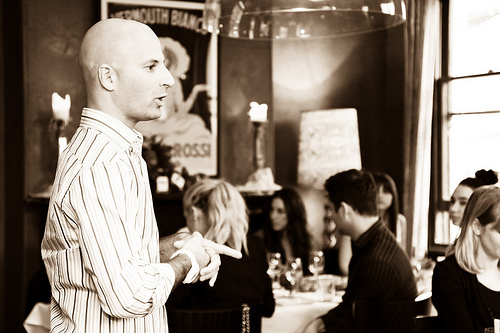
If you have a key account coming to a trade show, do whatever it takes to have him or her to yourself for the night. Don’t book the best restaurant in town. Book the most fun restaurant in town. The dinner is not about spreadsheets and marketing plans; it’s about eating great food, drinking plenty of great wine (or, in the case of some of our most “fun” accounts, getting blasted on shots of Jägermeister), and truly becoming friends with people whom you generally do not get to see outside of a corporate setting. There are going to be a few meetings that are a tougher “get,” and these are generally the very biggest companies at the show. If you’re struggling to get a meeting with them, ask around and find out if they are throwing a party. Yes? Great! Go and have fun and shake some hands. This is an infallible strategy — if you’re invited! If you aren’t invited, then you need to worm your way onto the guest list. The more exclusive the party, the more important it is to attend. So here’s our crash course in, well, crashing.
1. Ask your neighbors and customers what they are doing that evening; identify the big-ticket party for that night. Are you on the list? No? Then get working!
2. Find the best-looking and most genuinely charming guy or girl from your booth. Brief them on their objective and send them off to infiltrate the booth of the company hosting the party. Arm them with free samples and big smiles.
3. If that doesn’t work, find out where the party is, dress up, and tag along with a few other people that you know were invited and behave as though you own the joint (works 95 percent of the time). Effusively shake the host’s hand and thank him or her for the invite. Now that you’ve been such a mensch (gentleman) there’s no way they can kick you out!
4. Party like they are throwing the event just for you! Don’t act like a fool, but make sure everyone at the event knows that you are the life of the party.
5. Convince your most important suppliers/friends/staff to join you for after-party drinks at the bar in their hotel.
6. Look at your watch and realize that the conference floor opens in forty-five minutes! Run up to your room. Do fifty push-ups and drink three coffees.
7. Repeat every night till you are ready to cry with exhaustion.
8. Go home!
Treat your booth with love, and it will love you back.
First, make sure you have lots of products to swap at the end of the show! Your spouse/partner/roommate will be very happy because you can barter your stuff for other people’s stuff. Second, all conventioneers love getting products for free or in a barter. They’ll give it to their friends, or even better, give it to their family members, and there is nothing more effective than a buyer’s family liking the product. Most trade shows end in the early afternoon of the last day, and most trade show rules stipulate that all attendees keep their booths fully open till the very last minute of the last day of the trade show. But that last day is hard; you’re exhausted, and all you want to do is go home and sleep. You suddenly realize that consuming nothing but coffee and pretzels for four days is a questionable idea. By noon the convention floor is almost empty, with only a few people running around to wrap up last-minute deals. The temptation to put up your “closed” sign and slip some teamsters $500 to make your booth go away is HUGE.
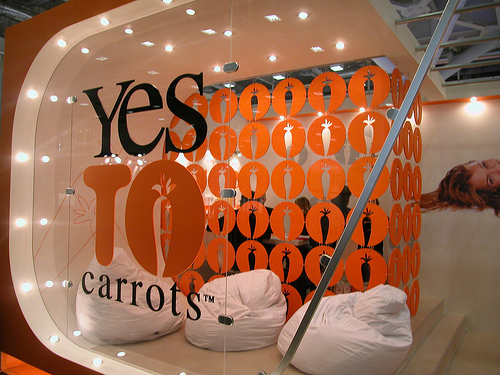
Don’t do it. As much as you may be sick of the sight of your booth by the end of an event, always treat it with respect. Remember that you are going to want to use parts of it again, so don’t just hand over the job of tearing it down to a couple of guys loitering around the coffee stand. Always make sure you know who is going to pull the booth down and where it is going to go. Make sure your original builder has supplied some kind of plan for safely packing and shipping the booth. We ended up flying two men over from Hungary to pull down our first booth; we reckoned that the additional investment was worth it if it improved our odds of still having a beautiful booth for the next trade show.
Third, and equally important, squeeze every drop of value out of that show. The last day is generally quieter and slower and you never really know who might show up at the booth. If the last day is very quiet, it can be a good time to start following up on the people you and your team met during the show. Make sure you speak to the show organizers to secure you the same or a better location for your booth for next year. (If you forget to do this, you may end up wedged in between the line for the toilets and the rubbishy food outlets. Not good.)
The Multibooth Philosophy

After a show, our booth is shipped back to a storage facility, which is a little like the government warehouse in Raiders of the Lost Ark. We have various booths in storage crated up and ready to go. Our philosophy is to never show the same booth twice at the same convention or trade show. For example, the Taj Mahal Carrot will never go back to Hong Kong, but it will do very well at Las Vegas. The goal is to keep things surprising and fresh. You want people to be curious about what you’ve done differently from last time, and by rotating the booths we maximize the chances of our important accounts seeing something new every year. You may not have the budget for this; if that’s the case, then get creative. Keep the same basic shell, the same colors and overall design philosophy, but change things up a little. Have fun, but make sure your aesthetics align over the years. You want to surprise people, not confuse them.
Getting people excited about Yes To was the easy part. The hard part was everything else! Even while we were circling the world on the Trade Show Express, we had to deal with the nuts and bolts of actually manufacturing and shipping ever-increasing amounts of product. Now, remember how we talked about how partners have to work well together, in good times and bad? Another one of those bad times is coming up right now.
Additional Resources
Trade Show Directories and Tips
2012 Top 250 US Trade Shows
Trade Shows, Exhibitions, Conferences & Business Events Worldwide
Exhibitor Magazine’s Exhibit Design Awards
Exhibitor Magazine’s Sizzle Awards
22 Tips on How to Operate a Trade Show Booth
Exhibitor Central – Tradeshow Tips
Barzilai Design (our exhibit design firm)
Tools
Evernote (for note taking)
BuildASign (for signs and print)
Chimpadeedoo (for capturing leads)
Square (for collecting payment)
Cafepress (for schwag)
InternMatch (for finding booth staff)
For the detailed story of Yes To’s improbable rise, including the stupid mistakes, near fatal catastrophes, existential crises, and fancy sales footwork, check out Get Big Fast and Do More Good: Start Your Business, Make It Huge, and Change the World.






November 3, 2013
“Productivity” Tricks for the Neurotic, Manic-Depressive, and Crazy (Like Me)

Sometimes, life seems upside-down.
I originally wrote this post months ago, but I’ve been too self-conscious to publish it until now. This quote convinced me to put on my big girl pants:
“The moment that you feel that, just possibly, you’re walking down the street naked, exposing too much of your heart and your mind and what exists on the inside, showing too much of yourself. That’s the moment you may be starting to get it right.”
- Neil Gaiman
University of the Arts Commencement Speech
So, here goes, and I hope it helps at least a few of you.
Reality Check
A few months ago, I had a birthday party.
A dozen friends and I gathered for several days of wonderful sun, beach, and catching up. On the last day, I didn’t get up until 11:30am, knowing full well that the last remaining friends were leaving at 12 noon.
I was afraid of being alone.
Like a child, I hid my head under the covers (literally) and hit snooze until reality couldn’t be postponed any further.
But…why am I telling you this?…
The Dangerous Myths of “Successful” People
We all like to appear “successful” (a nebulous term at best) and the media like to portray standouts as superheroes.
Sometimes, these dramatic stories of overcoming the odds are inspiring. More often, they lead to an unhealthy knee-jerk conclusion:
“Well… maybe they [entrepreneur/artist/creator painted as superhero] can do it, but I’m just a normal guy/girl…”
This post is intended to give a behind-the-scenes look at my own life. Though I’ve occasionally done profiles like A Day In The Life with Morgan Spurlock’s crew, I rarely let journalists follow me for a “normal” day. Why?
I’m no superhero. I’m not even a consistent “normal.”
In the last 3 months, I’ve:
Cried while watching Rudy.
Repeatedly hit Snooze for 1-3 HOURS past my planned wake time, because I simply didn’t want to face the day.
Considered giving everything away and moving to Montreal, Seville, or Iceland. Location varies based on what I’m escaping.
Seen a therapist for the first time, as I was convinced that I was doomed to life-long pessimism.
Used gentlemanly (ahem) websites to “relax” during the day when I clearly have urgent and important shit to do.1
Taken my daily caffeine intake (read: self-medication) so high that my “resting” pulse was 120+ beats per minute. 8-10 cups of coffee per day minimum.
Worn the same pair of jeans for a week straight just to have a much-needed constant during weeks of chaos.
Seems pretty dysfunctional, right?
But, in the last 8 weeks, I’ve also:
Increased my passive income 20%+.
Bought my dream house.
Meditated twice per day for 20 minutes per session, without fail. This marks the first time I’ve been able to meditate consistently.
I’ve cut my caffeine intake to next-to-nothing (in the last 4 weeks): usually pu-erh tea in the morning and green tea in the afternoon. I’ve had no more than 1 cup of coffee per week. More on this in a later post.
With your help, raised $100,000+ for charity:water for my birthday. (Thanks to John Park for bringing the thunder!)
Raised $250,000 in 53 minutes for a start-up called Shyp.
Signed one of the most exciting business deals of my last 10 years.
Added roughy 20 pounds of muscle after learning the pain and joy of high-rep front squats (and topical DHEA, courtesy of Patrick Arnold).
Transformed my blood work.
Realized — once again — that manic-depressive symptoms are just part of entrepreneurship.
Come to feel closer to all my immediate family members.
The Point
Most “superheroes” are nothing of the sort. They’re weird, neurotic creatures who do big things DESPITE lots of self-defeating habits and self-talk.
Personally, I suck at efficiency (doing things quickly). Here’s my coping mechanism and 8-step process for maximizing efficacy (doing the right things):
1) Wake up at least 1 hour before you have to be at a computer screen. E-mail is the mind killer.
2) Make a cup of tea (I like pu-erh) and sit down with a pen/pencil and paper.
3) Write down the 3-5 things — and no more — that are making you most anxious or uncomfortable. They’re often things that have been punted from one day’s to-do list to the next, to the next, to the next, and so on. Most important usually = most uncomfortable, with some chance of rejection or conflict.
4) For each item, ask yourself:
- “If this were the only thing I accomplished today, would I be satisfied with my day?”
- “Will moving this forward make all the other to-do’s unimportant or easier to knock off later?”
5) Look only at the items you’ve answered “yes” to for at least one of these questions.
6) Block out at 2-3 hours to focus on ONE of them for today. Let the rest of the urgent but less important stuff slide. It will still be there tomorrow.
7) TO BE CLEAR: Block out at 2-3 HOURS to focus on ONE of them for today. This is ONE BLOCK OF TIME. Cobbling together 10 minutes here and there to add up to 120 minutes does not work.
8) If you get distracted or start procrastinating, don’t freak out and downward spiral; just gently come back to your ONE to-do.
Congratulations! That’s it.
This is the only way I can create big outcomes despite my never-ending impulse to procrastinate, nap, and otherwise fritter away my days with bullshit. If I have 10 important things to do in a day, it’s 100% certain nothing important will get done that day. On the other hand, I can usually handle 1 must-do item and block out my lesser behaviors for 2-3 hours a day.
It doesn’t take much to seem superhuman and appear “successful” to nearly everyone around you. In fact, you just need one rule: What you do is more important than how you do everything else, and doing something well does not make it important.
If you consistently feel the counterproductive need for volume and doing lots of stuff, put these on a Post-it note:
Being busy is a form of laziness–lazy thinking and indiscriminate action.
Being busy is most often used as a guise for avoiding the few critically important but uncomfortable actions.
And when — despite your best efforts — you feel like you’re losing at the game of life, remember: Even the best of the best feel this way sometimes. When I’m in the pit of despair, I recall what iconic writer Kurt Vonnegut said about his process: “When I write, I feel like an armless, legless man with a crayon in his mouth.”
Don’t overestimate the world and underestimate yourself. You are better than you think.
And you are not alone.
And If You Struggle…
If you occasionally struggle like me, these resources and articles might help you rebound:
The Prescription for Self-Doubt (Video)
Harnessing Entrepreneurial Manic-Depression: Making the Rollercoaster Work for You
Two Root Causes of My Recent Depression (by Brad Feld, one of my favorite start-up investors)
Did you find this post helpful? Please let me know, and if you have any particular strategies or quotes that help get you out of funks, please share in the comments!
Any guy who insists he’s never done this should not be trusted.






October 30, 2013
The Tim Ferriss Experiment (TFX) TV Trailer
Just a taste of things to come!
For more info on the show, see this post.
The uber-short version:
The Tim Ferriss Experiment (TFX) premieres December 1st at 8pm EST on Upwave on HLN (Formerly CNN Headline News). Here’s Turner’s show site.








